Horrors old and new
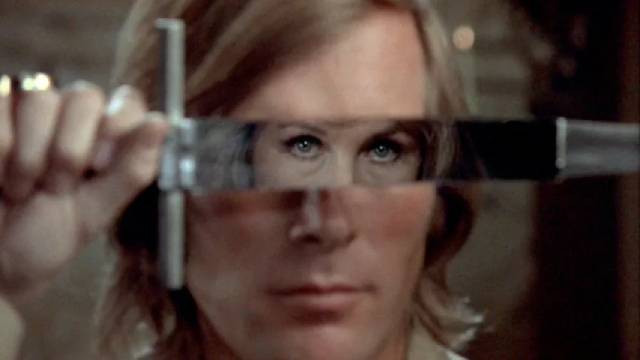
Genre is one of those things which we recognize when we see it, though it’s not so easy to pin down and define with complete certainty. We lump things together based on certain characteristics, even when they might differ in many details and perhaps bear little resemblance to one another in style and tone and narrative content. The western might seem like an obvious type – 19th Century setting, open plains, deserts, sometimes mountains, but typically depicting conflicts between armed men on horseback – but western tropes can be found elsewhere, for instance in samurai movies like Akira Kurosawa’s Seven Samurai (1954) or Yojimbo (1961), both of which were, ironically, remade as westerns (John Sturges’ The Magnificent Seven [1960] and Sergio Leone’s A Fistful of Dollars [1964] respectively). Michael Reeves even acknowledged the influence of the western on Witchfinder General (1968), set during the English Civil War in the 17th Century.
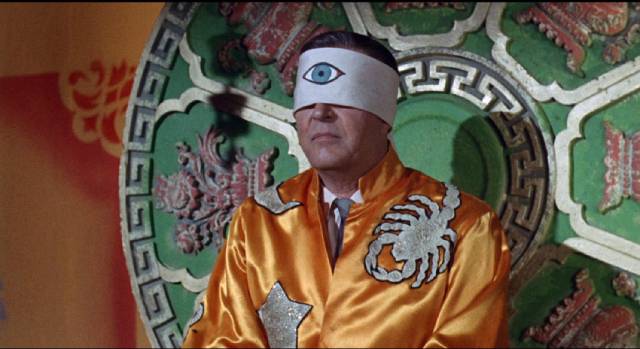
The challenge posed to any filmmaker approaching a genre project is finding a balance between familiar tropes and original ideas; too much of the former and you risk boring an audience, leaning too far on the latter and audience expectations might be frustrated. (Radical blending or distortion of genre tropes can lead to audience confusion and commercial failure even when the resulting movie is an imaginative tour de force like W.D. Richter’s Buckeroo Banzai [1984] or John Carpenter’s Big Trouble In Little China [1986], which coincidentally was co-written by Richter.) In addition, changing social conditions produce constantly mutating forms – in the 1920s and ’30s, horror drew on 19th Century literature for German Expressionist movies like F.W. Murnau’s Nosferatu (1922), a version of Dracula, and Der Januskopf (1920), a version of Dr. Jekyll and Mr. Hyde, and the influential Universal horrors adapted from Dracula, Frankenstein, H.G. Wells and Edgar Allan Poe, themselves also influenced by German Expressionism.
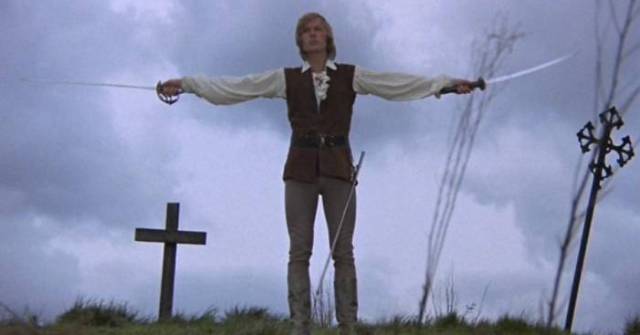
By the ’50s, after the horrors of World War Two, the genre took on a gloss of science with monsters created by radiation, though at the end of the decade, filmmakers in Britain, the U.S. and Italy returned to the 19th Century Gothic, but with a more explicit emphasis on graphic violence and psychological deviance. As that particular trend became exhausted towards the end of the ’60s, filmmakers brought the violence and deviance into contemporary settings with movies like Roman Polanski’s Rosemary’s Baby (1968) and William Friedkin’s The Exorcist (1973), while George A. Romero transformed the Gothic concept of zombies into something far more visceral and dangerous in Night of the Living Dead (1968), which replaced the supernatural with a scientific explanation (the menace of radiation resurfacing once again).
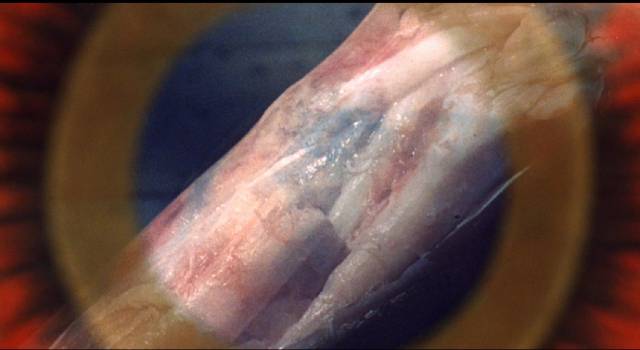
By the mid-’70s, horror was largely displaced in popular culture by science fiction (though here adventure and cautionary tales were often infused with horror elements – as in Ridley Scott’s Alien [1979] and John Carpenter’s The Thing [1982]). The most prominent strain of horror in the following two decades was the slasher (a collection of movies which narrowed the genre to a very limited number of tropes rooted in Carpenter’s Halloween [1978]), although a strong element of comedy ran parallel with this, largely inspired by Sam Raimi’s Evil Dead trilogy (1981, 1987, 1992). Both threads came together in the overtly self-aware and self-referential Scream movies made by Wes Craven in the ’90s and early ’00s.
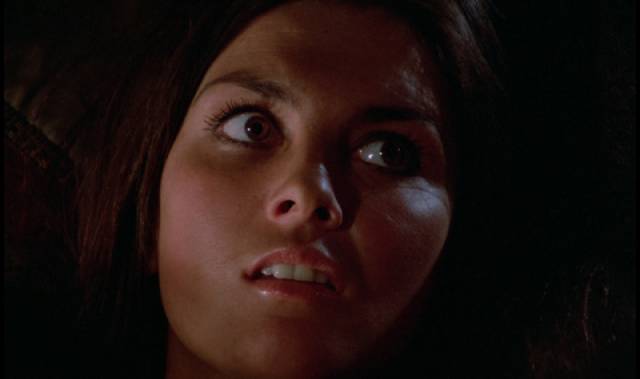
Perhaps in response to this meta-horror trend, some filmmakers resorted to extreme violence in the so-called torture porn subgenre, with movies like James Wan’s Saw (2004) and its countless sequels and Eli Roth’s Hostel movies (2005, 2007). These movies replaced traditional elements of unease and existential dread with an uncomfortable emphasis on bodily harm, a purely physical horror. The appeal of these movies, wallowing in sadism and nihilism, was limited and a kind of backlash arrived quickly with Oren Peli’s Paranormal Activity (2007), which took a determinedly minimalist approach to evoke a sense of insecurity in what ought to have been the safest place – a suburban family home. While few people could personally identify with the victims in Saw and Hostel, almost everyone could be disturbed by the idea of something unseen and menacing which lurked in their own personal space as they slept.
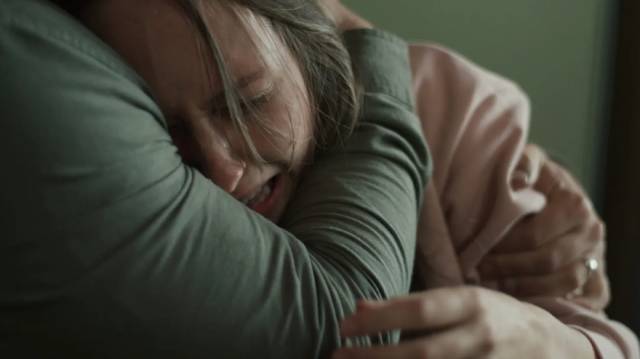
Drawing on the found-footage style of Daniel Myrick and Eduardo Sanchez’s The Blair Witch Project (1999), Paranormal Activity launched an entire industry of suggestive horror supposedly caught by chance on the ubiquitous cameras society had given to most of its members – home security cameras, cell phones, cheap consumer equipment which made it possible for virtually anyone to become a filmmaker.
Throughout all these changes, the essence of horror remains the idea that what we know of the world is incomplete, that our sense of security is, at least in part, an illusion; that there are things unseen which may at any moment rear up and threaten us. These threats might be unknown scientific developments or supernatural manifestations, but either way they suddenly reveal that what we’ve always taken for granted is just a partial picture of reality – that, as H.P. Lovecraft asserted, just below the skin of material reality lie cosmic horrors which might obliterate us without warning. Which is why so much of horror ends with a bleak assertion that “normality” can never be fully restored; once you know the truth you can never un-know it.
*
As always, horror has played a part in my recent viewing, with a number of movies from different periods representing quite different styles and approaches.
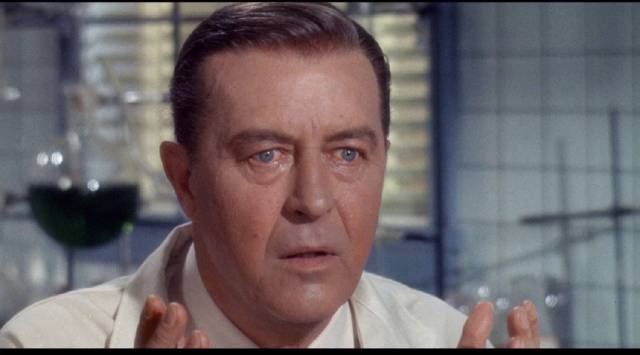
X: The Man With the X-Ray Eyes (Roger Corman, 1963)
Roger Corman already had a very eclectic filmography (twenty-five movies in five years, ranging from horror to sci-fi to teen exploitation and westerns) when he made his first Poe adaptation in 1960; partially inspired by Hammer’s Gothic revival in England, and concurrent with Mario Bava initiating the Italian Gothic explosion with Black Sunday (1960), The Fall of the House of Usher marked a new direction for Corman – his first film in colour, with his biggest budget up until that point, it revealed the filmmaker to be somewhat more serious about his craft than his previous scrappy exploitation movies might suggest; with its literary origins and its perverse undercurrents, it displayed Corman’s knowledge of and appreciation for classical horror, which he astutely combined with his well-honed business instincts.
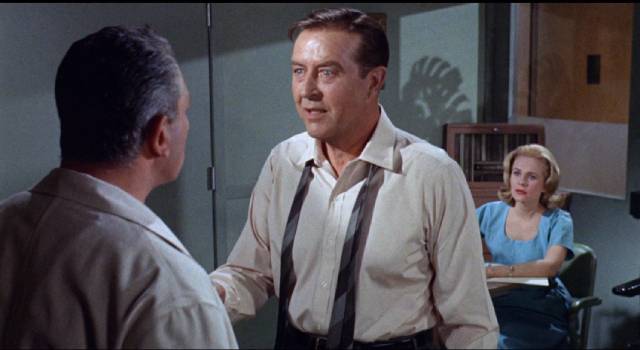
Although he continued for a while to make movies like those of the ’50s, and at times tempered the Gothic with rather broad comedy (in Tales of Terror [1962] and The Raven [1963]), he built on the relative prestige of Usher with half-a-dozen other period Gothics over the next four years, climaxing with two features made in England in 1964 – The Masque of the Red Death and The Tomb of Ligeia. And in the midst of this impressive run, he made what I (and some others) consider to be his best movie, X: The Man With the X-Ray Eyes (1963) … or simply X as it says on the actual print.
Its contemporary setting and emphasis on scientific horror shows Corman taking a determined break from Poe and Vincent Price; rather than 19th Century literature, its roots go back to the mad scientist movies made by Universal, Columbia and various poverty row studios in the ’30s and ’40s, more Invisible Ray than Dracula. Perhaps the key difference between these scientific horrors and the supernatural is the protagonist who actively goes in search of that knowledge beyond everyday experience, rather than having previously unknown forces impinge on quotidian life.

Dr. Xavier (Ray Milland) uses his hospital lab to pursue his radical quest to “see more”. While the human eye can perceive only a narrow range of the electromagnetic spectrum, he wants to see whatever else lurks beyond the material surface of the world. And so he comes up with some potent eye drops which, when administered to a monkey, cause the animal to die of fear from whatever it has seen. Undeterred, he figures that an educated, self-aware human being ought to be able to process the new knowledge the drug will reveal … so he tests it on himself.
At first, the experiment seems successful; visiting a young girl scheduled for heart surgery, he can see into her body and realizes that the head surgeon’s diagnosis is incorrect and that the procedure as scheduled is likely to kill her. So in the operating room he hijacks the operation (slicing the surgeon’s hand to make it impossible for him to proceed) and saves the girl’s life. However, his unorthodox behaviour will get him a malpractice charge despite the outcome – and the confirmation that he really does have x-ray vision. This puts him over the edge and in a state of anger about the injustice, he accidentally knocks his friend Dr. Sam Brant (Harold J. Stone) out of a window. Already facing professional censure, he’s now wanted for murder and goes underground, taking his eye drops with him to continue his experiment.

In the second act, Xavier has assumed the identity of Mentalo, a sideshow performer who uses his enhanced vision to impress the rubes with a faux mind-reading act. Although he impresses the other carnies with his “tricks”, the sleazy opportunist Crane (Don Rickles) realizes who he really is and what his actual powers are, blackmailing him into becoming a back-alley “healer” to fleece desperate people out of what little money they have by diagnosing their medical problems – although he can’t actually heal anyone, he can arm them with detailed knowledge of their condition so they can go to an actual doctor to get help.
This helps his former colleague Dr. Diane Fairfax (Diana Van der Vlis) to track him down and encourage him to escape Crane’s toxic influence. Infuriated, Crane rats him out to the police and Xavier and Diane flee into the desert. Needing money to make a conclusive getaway, they go to Las Vegas where he uses his vision to win, first at a slot machine, then at the blackjack table. But by this point, Xavier has become petty unhinged, his ability to see more than mere mortals feeding a narcissistic sense of superiority and a contempt for ordinary people – rather than being cautious and walking away when he’s won enough, he flaunts his ability to predict the cards, raising the suspicions of the casino management and losing all the money in the sudden need to escape quickly as the police are called.
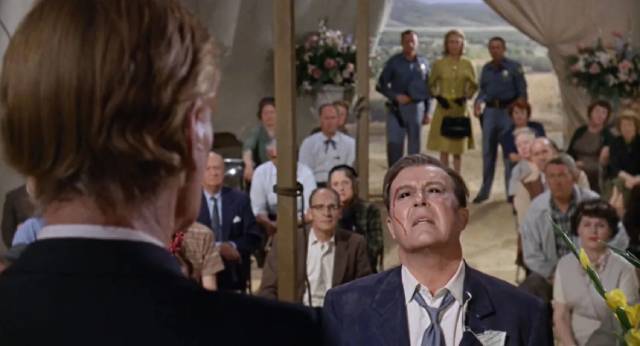
Fleeing again, pursued into the desert by a police helicopter, he finds his way to a shabby revival tent where he follows the altar call of the preacher (John Dierkes) and testifies to having seen to the heart of creation and the great cosmic eye which looks back at us. Not surprisingly, the preacher senses something demonic and utters the Biblical admonition to pluck out your eyes if they offend you…
The protagonists of scientific horror stories are generally not victims of external forces, but rather active agents responsible for their own problems; this is definitely the case with Xavier, who begins with a determination to expand knowledge for its own sake, but as he succeeds is overwhelmed by hubris and contempt for mere mortals who don’t have access to what he now knows. With a tight script by Ray Russell (polished by Robert Dillon), a committed performance by Milland, and Corman’s own well-honed proficiency, X: The Man With the X-Ray Eyes is a flawless example of sci-fi/horror, its narrative and dramatic strengths more than sufficient to make up for the budgetary limitations which keep the visual expression of Xavier’s new ability to see beyond the surface of the world rudimentary – a blend of filters, distorting lenses and optical tricks.
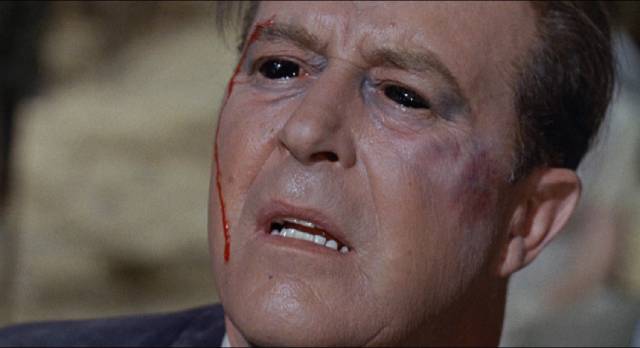
Second Sight’s 2020 limited edition looks great, with a strong image, clean sound, and a mix of new and archival extras – the former an on-camera interview with the genial Corman talking about making the film and what he would do differently with new digital technology, and an interview with Kat Ellinger about American Gothic (literature and film). There are two commentaries carried over from a previous Kino Lorber edition, along with a brief interview with Joe Dante, a Trailers From Hell commentary from Mick Garris and the original trailer. Also included in the slipcase is a poster and a booklet containing a couple of essays.
*
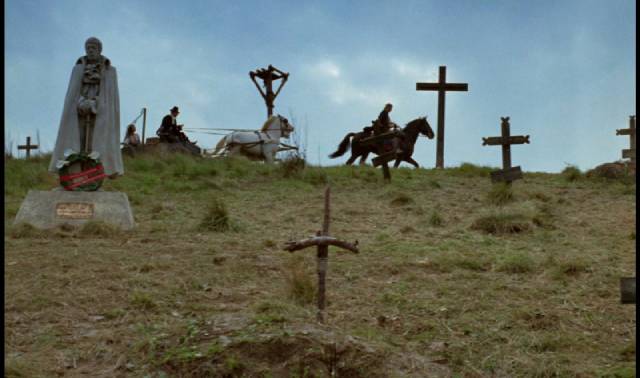
Captain Kronos: Vampire Hunter (Brian Clemens, 1974)
Although Hammer Films had broken new ground in the ’50s, pushing the boundaries of what the censors allowed in terms of violence in particular, and spurring a revival on both sides of the Atlantic of classical Gothic dressed up in colour and gore effects, by the late ’60s the company’s movies had begun to look a tad old-fashioned. After Psycho, Hammer had launched a parallel line of contemporary thrillers, but even though some of these were pretty good, they never gained the market profile of the period horrors. Facing declining profits, Hammer tried to give this staple a boost by adding a dose of sex – the Karnstein vampire trilogy (1970-71), Countess Dracula (1971) – and attempted to bring the Gothic into the present by transplanting the Count into contemporary London with Dracula A.D. 1972 (1972) and The Satanic Rites of Dracula (1973). Their final horror production was an ill-fated attempt to follow up the success of William Friedkin’s The Exorcist (1973) by updating Dennis Wheatley’s To the Devil a Daughter (1976).
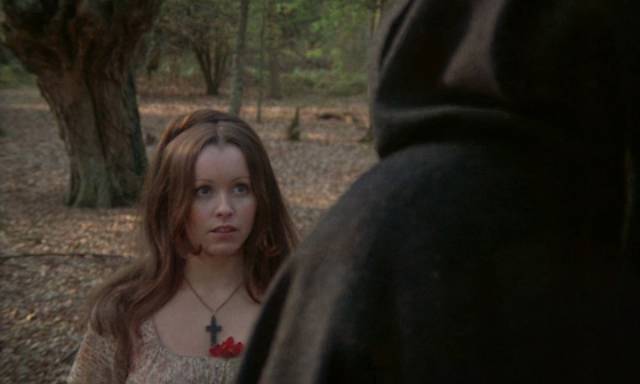
But as Hammer struggled to reassert itself in the marketplace, they attempted a couple of other strategies, most prominently with a string of big-screen adaptations of popular television sit-coms. In the horror realm, they laid Frankenstein to rest with Terence Fisher’s underrated Frankenstein and the Monster from Hell (1974) and finished off Dracula with the odd hybrid co-production with Shaw Brothers in Hong Kong, The Legend of the 7 Golden Vampires (also 1974). But in the midst of this quest to redefine themselves for a rapidly changing audience, they made a handful of experiments in genre and form – a mix of psychological horror and period trappings in Hands of the Ripper (1971) and Demons of the Mind (1972), and a couple of vampire films which veered far off the well-trodden path of the long-running Dracula saga. First was Robert Young’s carnivalesque Vampire Circus (1971); this was followed by Brian Clemens’ Captain Kronos: Vampire Hunter, which was shot in 1972, but not released until 1974 – a delay which did the film, and the studio, few favours.
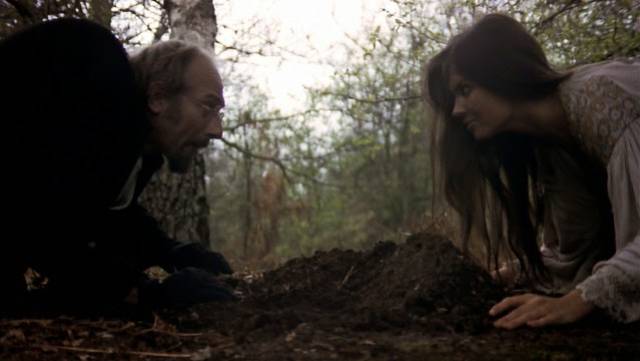
Brian Clemens was an incredibly prolific writer – if you count all the episodes of multiple television series as well as his film work, he has well over four-hundred credits, plus quite a few stage plays – whose influence on British TV is incalculable. His early work churning out B-movie scripts for the Danziger Brothers, transplanted Americans who produced a copious number of cheap exploitation movies throughout the ’50s, along with some popular TV shows, trained him to be quick and economical, skills which served him very well when he got involved in television in the late ’50s. After contributing to various series, he wrote the pilot for Danger Man (1960-67), which propelled Patrick McGoohan to international stardom, and became involved in The Avengers (1961-69) very early, eventually taking over as script editor, associate producer and eventually chief writer, giving the series its familiar tone, mixing espionage, horror and science fiction with large doses of irreverent humour; he was also responsible for casting Diana Rigg as Mrs. Peel when Honor Blackman left during the fourth season.
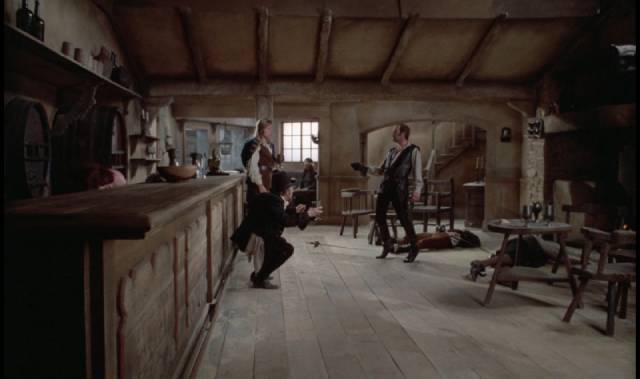
After a decade of working almost exclusively for television, Clemens wrote a number of features in the early ’70s, starting with Robert Fuest’s And Soon the Darkness (1970) and Richard Fleischer’s See No Evil (1971). Among them was Dr. Jekyll & Sister Hyde (also 1971), one of Hammer’s experiments in transforming familiar genre elements with an added dose of sex. Directed by Roy Ward Baker, the film was well-received and indicated that it was definitely possible to build on Hammer’s Gothic heritage with some imaginative changes. Approached to work for the company again, Clemens stipulated that he now wanted to direct as well as write a movie and, along with his producing partner Albert Fennell, he was essentially given carte blanche.

This freedom resulted in a new approach to vampires, with an emphasis on action and a focus on the hero rather than the blood-sucker. Merging the company’s familiar horror tradition with their swash-buckling period action movies – from The Stranglers of Bombay (1959) to The Pirates of Blood River (1962), The Scarlet Blade (1963) and several Robin Hood features – Clemens came up with a rousing adventure laced with horror elements and a trace of the humour he’d brought to his television work. Captain Kronos: Vampire Hunter turned out to be one of the best movies made by Hammer as it began its slide into decline. And yet, the studio’s reaction was hesitant. This was partly due to Michael Carreras, who had taken over full control of Hammer from his father James in 1972, and saw in Clemens’ approach a lack of respect for the studio’s heritage – which is perhaps an indication of what brought about its eventual demise, a deeply embedded, short-sighted conservatism.
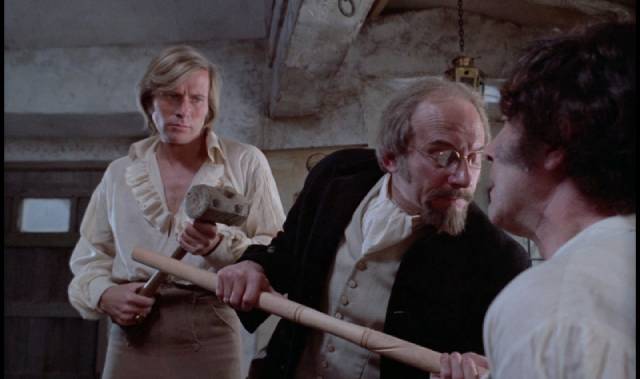
Set in the early 19th Century, the film plays two major variations on the vampire genre – first, it replaces the ever-so-serious Van Helsing figure armed with his Christian paraphernalia with Kronos (Horst Janson), a dashing cavalry officer who seeks out evil with sometimes overly impetuous bravado, and his companion, the hunch-backed Grost (John Cater), who has an encyclopedic knowledge of the supernatural; and second, it discards the entrenched lore of European vampirism. As Grost explains, there are as many kinds of vampire as there are predators in the natural world, and each must be dealt with in its own way. One of the film’s high points is a darkly comedic scene in which Kronos and Grost try a number of ways to dispatch their friend who has been infected – a stake through the heart doesn’t work, nor does hanging nor fire; they accidentally arrive at sacred steel as the solution, leading Grost to forge a sword from a metal cross stolen from the local graveyard.
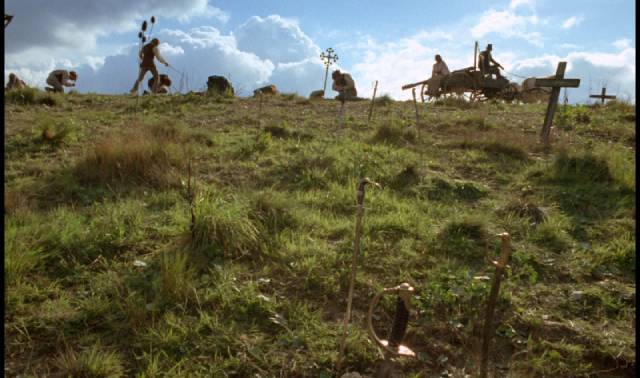
A series of unnatural deaths is plaguing a small village – young women are suddenly turned very old and quickly die. Local doctor Marcus (John Carson) calls in his friend Kronos, who arrives with his companion Professor Grost to investigate. They discern that the culprit is a vampire which sucks the youth out of its victims rather than blood. They set alarms and traps in the nearby woods and gradually home in on a local noble family, the Durwards; the father died a few years ago (for which they blame Dr. Marcus) and the mother is sick and confined to her room … which leaves son Paul (Shane Briant) and daughter Sara (Lois Daine) as likely suspects. Using gypsy girl Carla (Caroline Munro) as bait, Kronos draws out the actual monster(s) and uses the sword forged by Grost to dispatch the vampire in an energetic sword fight.
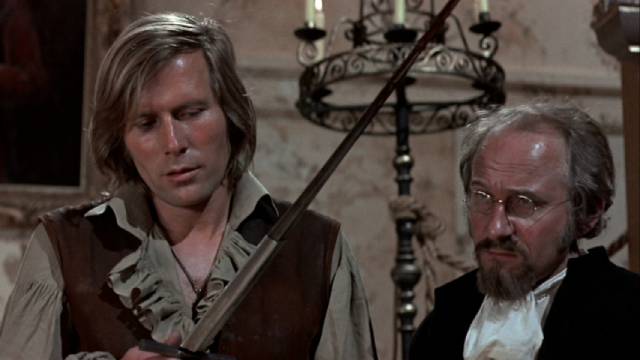
What Carreras objected to was the light and breezy tone, which does perhaps seem to mock the ponderous seriousness of the company’s earlier Gothics as it aims to appeal to a younger audience. Who knows what might have happened if Hammer had got behind the film and launched a new series (Clemens’ intention). But uncertain how to market it, they left it on the shelf for two years and finally dumped it as the bottom half of a double bill a year after The Exorcist fundamentally changed the horror landscape. To rub salt into the wound, the top half of the bill was taken by a six-year-old Shaw Brothers martial arts movie, Chang Cheh’s Golden Swallow (1968), renamed The Girl with the Thunderbolt Kick, to cash in on the new kung fu craze; coincidentally, Hammer had just co-produced The Legend of the 7 Golden Vampires with Shaw, so that also might have had something to do with it.
Sadly, Captain Kronos was the only movie Clemens directed; he went back to television, writing or co-writing all but one of the forty-four feature-length episodes of Thriller (1973-76) among numerous other shows (including the majority of episodes for The New Avengers [1976-77]).
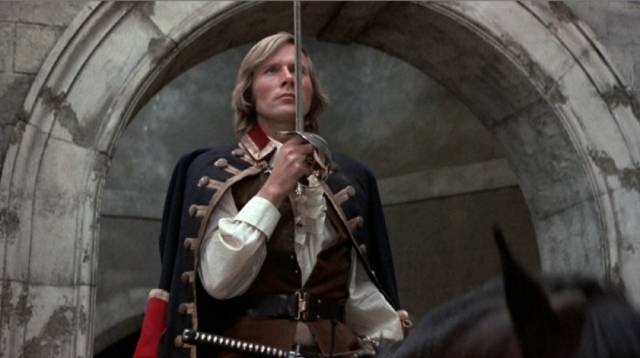
For some reason, Hammer have chosen Captain Kronos to launch a line of 4K restorations under their own studio banner and they’ve gone all out for this inaugural effort (followed by more modest editions of Terence Fisher’s Four Sided Triangle [1953] and Michael Carreras’ Shatter [1974], with another five-disk set of Val Guest’s The Quatermass Xperiment [1955] due in June). To be honest, I wouldn’t have bought this expensive release, but took advantage of the credit I received when I traded in a stack of Blu-rays, which to my way of thinking means I got it for free. Packed in a sturdy, over-sized slipcase, the set contains five disks (two 4K UHD and three BDs), a 132-page book of essays, articles, interviews and promotional materials, a 96-page comic adaptation of the film and a potential sequel, a set of lobby cards and a poster.
The disks include three different versions of the film, though they aren’t variant cuts – instead, they offer three different aspect ratios; the British 1.66:1, the U.S. 1.78:1, and an open-matter 1.33:1 transfer of the full 35mm frame. This does seem like a bit of overkill – the most pleasing frame is the 1.66:1, with the U.S. version making head and foot room a bit tighter, and the open-matte too loose and unfocused. But there’s no arguing with the quality of the image itself, which is sharp and colourful; Ian Wilson’s cinematography may not be as atmospheric as Jack Asher’s or Arthur Grant’s on the studio’s classic Gothics, but it is well suited to the film’s action-adventure approach. Soundtrack options include the original mono plus 5.1 and Atmos remixes.
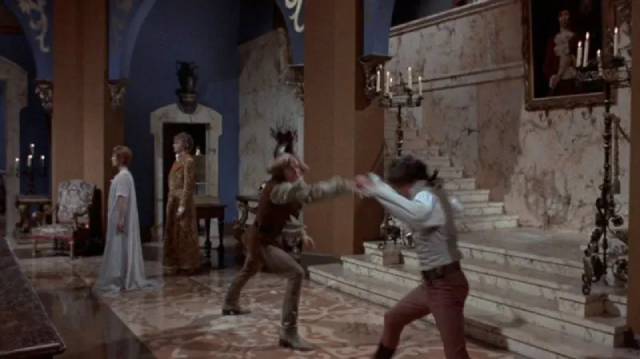
Extras include intros to each version, plus commentaries featuring Caroline Munro, Brian Clemens, his sons Sam and George, and cast and crew members and film historians. There’s an archival featurette from 2008 about a cast and crew reunion, archival interviews with Clemens, Horst Janson and Lois Daine; a conversation between Kim Newman and Stephen Jones about Hammer’s attempts to rethink horror in the ’70s; and a charming one-hour documentary in which Toby Hadoke visits the Clemens family home – a converted farm – which is very much a museum devoted to Brian Clemens’ life and career, packed with artifacts reflecting the remarkable range of his film and television work. Over a few days, Hadoke is hosted and guided through the collection by Clemens’ widow and two sons, all fleshed out with interview clips from his colleagues and, in archival recordings, Clemens himself.
It’s a terrific set and might spur me to track down subsequent releases (though I’m not a fan of Shatter, Four Sided Triangle is a favourite, and Quatermass an absolute must-have).
*
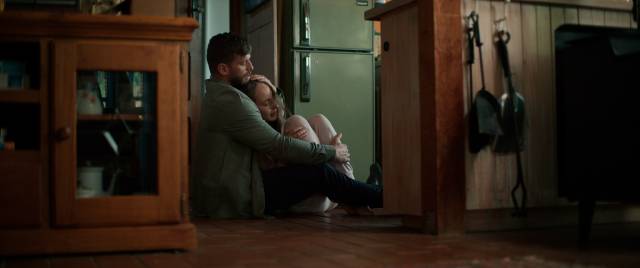
Godless: The Eastfield Exorcism (Nick Kozakis, 2023)
You couldn’t get much farther away from a small 19th Century European village than a working class suburb of Melbourne, Australia, in the early 1990s, but the superstitions in this community are more terrifying than the mythical vampires of Captain Kronos. Nick Kozakis’ Godless: The Eastfield Exorcism (2023) is based on an actual case from 1993 – though names have been changed and some liberties taken in visualizing purely subjective experiences. It’s a harrowing, and ultimately rather depressing story, but Kozakis tells it well, aided by a cast who handle the ambiguities effectively.
Lara Levonde (Georgia Eyers) is in severe psychological distress and the therapy sessions and drugs provided by Dr. Marisa Walsh (Eliza Matengu) don’t seem to be helping, which undermines the doctor’s determined resistance to pressure from Lara’s husband Ron (Dan Ewing) to sign papers asserting that medical science has been exhausted and Lara is a candidate for an exorcism – apparently a requirement of the Catholic Church. Ron’s anger is fed by his deeply ingrained religious beliefs – he belongs to a fundamentalist congregation – and an escalating sense of shame that his wife has somehow let in a demon which has taken control of her.
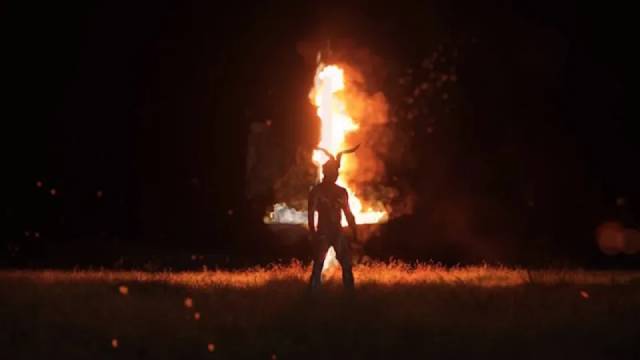
While what he can see is an increasing retreat from reality, accompanied by sleepwalking and blackouts (Lara wanders out into the garden at night to dance naked under the moon), what the audience is shown are visions of a burning man and a demon which is seizing increasing control of her. Pale and lost, Lara has no strength to assert herself against Ron’s “diagnosis” of her problem and stops taking the antidepressants prescribed by Dr. Walsh, though without them her visions intensify.
Meanwhile Ron consults with his pastor, Barbara (Rosie Traynor), who believes only in the power of faith – she tells him of a man whose wife was dying of cancer and how the treatments with toxic drugs just added to her sickness; on Barbara’s advice, the couple withdrew from treatment … the woman died, but at least she’s now with God. Ending Lara’s therapy doesn’t help, so Barbara calls in the self-appointed exorcist Daniel (Tim Pocock), unsanctioned by any church but driven by an unshakable conviction of his power to drive out demons. His methods are harsh and abusive – he assures Ron that he shouldn’t be troubled by the physical and psychological abuse about to be inflicted on Lara, because all the suffering he’s going to be causing will be experienced not by her but by the demons inside her.

And so Lara is bound to a chair in the garage, deprived of food and drink and hygiene, and subjected to intense verbal abuse which escalates to blows and eventually torture – the more the “demon” resists, the harsher the treatment becomes. Barbara calls in members of the congregation to add the reinforcement of their prayers, and even though a few of them are disturbed by what they see, their conviction that they’re helping to free Lara from possession prevents them from interceding. At one point, Lara manages to escape into the surrounding woods, but she’s found and dragged back … and one woman does finally call the police, but they hesitate to step in because they don’t want to be seen interfering with anyone’s religious freedom. This last seems to be stretching plausibility, but apparently was the case.
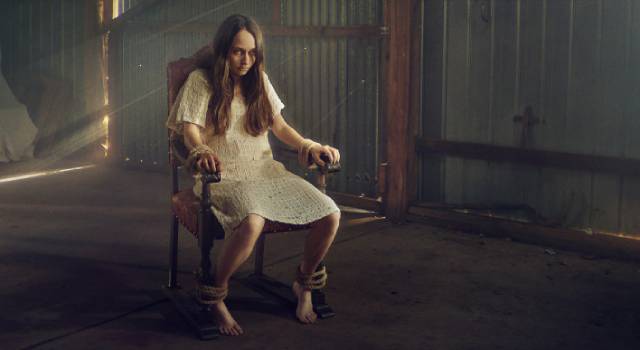
As Daniel’s abuse reaches intolerable proportions, we are finally given access to the real cause of Lara’s condition, an unbearable trauma in which she was driving with her husband and baby when a momentary distraction resulted in a crash which not only killed her husband and child, but also saw the other driver trapped in his vehicle and burned alive. No demons, just an unresolved sense of guilt and despair, something which Ron’s religious convictions have in part prevented her from processing in a productive way – without his counter-pressure, perhaps Dr. Walsh might have been able to help her work through the trauma after all.
But that’s all moot, because under Daniel’s physical and emotional assault Lara dies. Which Daniel immediately transforms into a miracle – her body has died in order to free her spirit from the possession and in three days she will rise from the dead, reborn free and healthy. And still the police don’t step in as people gather from afar to witness this miraculous resurrection, concealing the horror beneath a carnivalesque veneer of ecstatic faith. But all this dissolves when Lara stubbornly refuses to return, apparently preferring to remain with God rather than rejoin her living community.
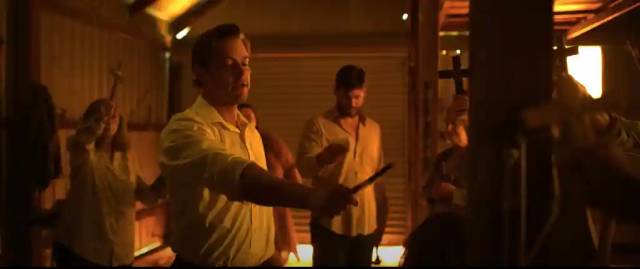
Only then do the police step in to file some charges, though as in the real case none of those involved received more than a small, token sentence for false imprisonment and manslaughter. Because, of course, they had acted out of sincere religious beliefs.
The film ends with a title card listing a number of people who have died during such “exorcisms”.
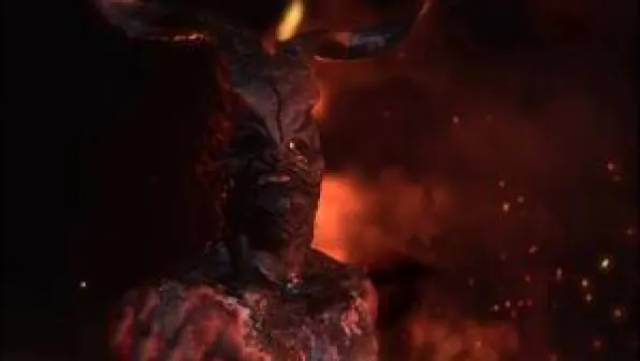
Possession and exorcism movies almost universally treat their stories at face value – from The Exorcist on, they accept that demons are real and that those fighting them are on the side of good, even something as egregious as Scott Derrickson’s The Exorcism of Emily Rose (2005), which uses an actual court case to argue for the reality of demons. Kosakis’s film takes the opposite (cinematically minority) position, that these religious beliefs are delusional and dangerous, effectively undercutting familiar narrative tropes with his late revelation of what actually lies behind Lara’s torment, clearly showing this fragile, damaged woman to be the helpless victim of her husband and his church community.
Umbrella’s limited edition Blu-ray presents the gritty, low-budget film in an authentic-looking transfer, supplemented with two commentary tracks and a number of cast and crew interview featurettes.
Comments